The AMD Radeon R9 Nano Review: The Power of Size
by Ryan Smith on September 10, 2015 8:00 AM ESTCompute
Shifting gears, we have our look at compute performance.
Starting us off for our look at compute is LuxMark3.0, the latest version of the official benchmark of LuxRender 2.0. LuxRender’s GPU-accelerated rendering mode is an OpenCL based ray tracer that forms a part of the larger LuxRender suite. Ray tracing has become a stronghold for GPUs in recent years as ray tracing maps well to GPU pipelines, allowing artists to render scenes much more quickly than with CPUs alone.
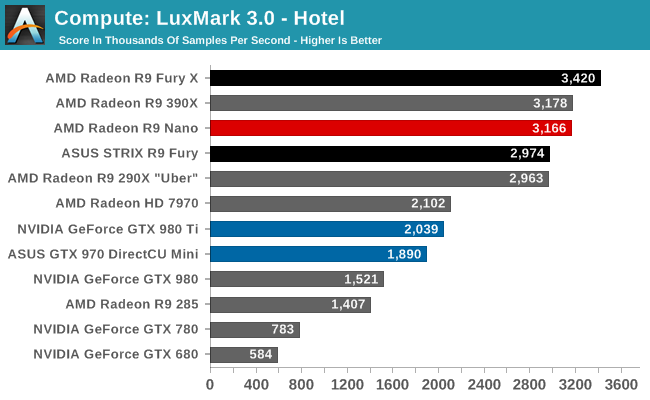
LuxMark ends up being a great corner case for where having a fully enabled Fiji GPU is more important than having the highest clockspeeds. With the R9 Nano able to flirt with its full 1000MHz clockspeed here, the card is able to pass the R9 Fury here. The only thing stopping it from taking the second-place spot is the R9 390X, as Hawaii still sees strong performance here even with fewer SPs.
For our second set of compute benchmarks we have CompuBench 1.5, the successor to CLBenchmark. CompuBench offers a wide array of different practical compute workloads, and we’ve decided to focus on face detection, optical flow modeling, and particle simulations.
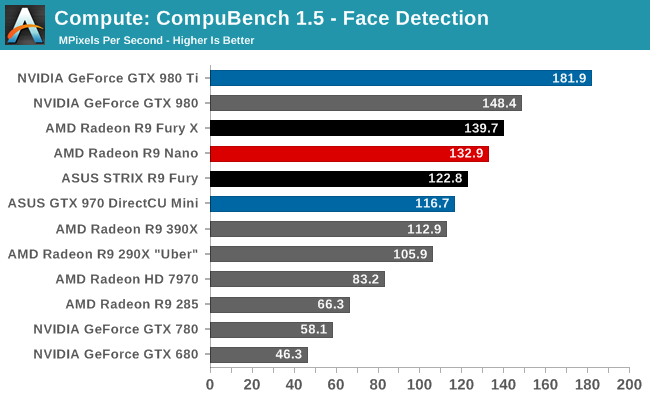
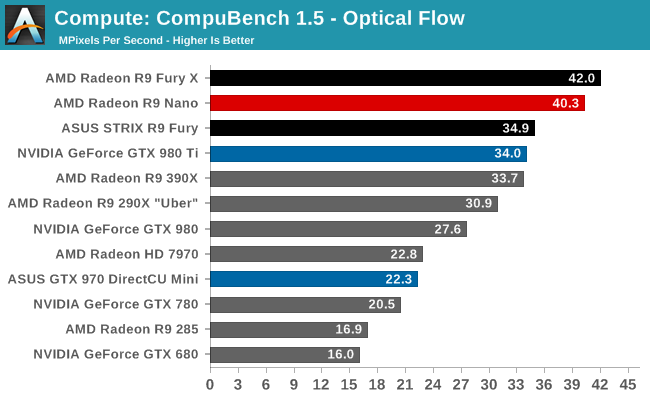
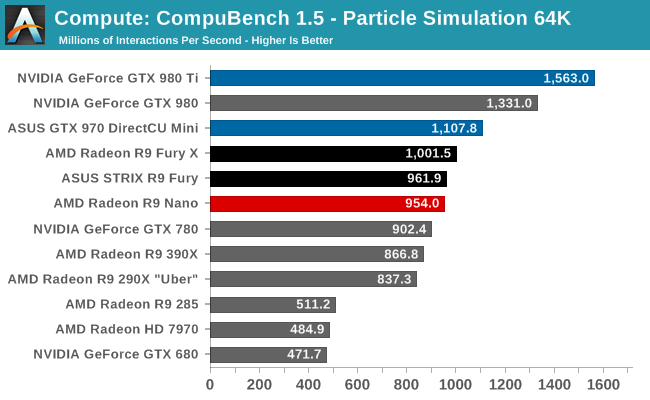
CompuBench provides us another case of where the R9 Nano ends up outpacing the R9 Fury. As a result AMD’s latest card tends to perform somewhere between an R9 Fury and R9 Fury X, with all of the strengths and weaknesses that come from that. This puts the R9 Nano in a good place for Optical Flow, while it will still trail NVIDIA”s best cards under Face Detection and the 64K particle simulation.
Meanwhile it’s interesting to note that AMD’s particle sim scores have significantly improved in the recent drivers. GCN 1.2 cards have seen 20%+ performance improvements here, which may point to some new OpenCL compiler optimizations from AMD.
Our 3rd compute benchmark is Sony Vegas Pro 13, an OpenGL and OpenCL video editing and authoring package. Vegas can use GPUs in a few different ways, the primary uses being to accelerate the video effects and compositing process itself, and in the video encoding step. With video encoding being increasingly offloaded to dedicated DSPs these days we’re focusing on the editing and compositing process, rendering to a low CPU overhead format (XDCAM EX). This specific test comes from Sony, and measures how long it takes to render a video.
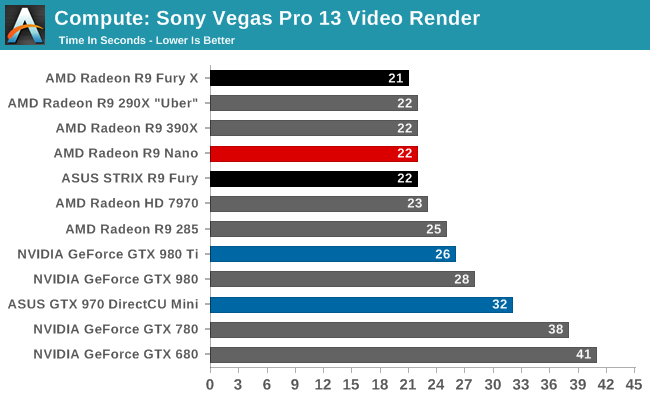
With Vegas there are no surprises; the R9 Nano ties the R9 Fury.
Moving on, our 4th compute benchmark is FAHBench, the official Folding @ Home benchmark. Folding @ Home is the popular Stanford-backed research and distributed computing initiative that has work distributed to millions of volunteer computers over the internet, each of which is responsible for a tiny slice of a protein folding simulation. FAHBench can test both single precision and double precision floating point performance, with single precision being the most useful metric for most consumer cards due to their low double precision performance. Each precision has two modes, explicit and implicit, the difference being whether water atoms are included in the simulation, which adds quite a bit of work and overhead. This is another OpenCL test, utilizing the OpenCL path for FAHCore 17.

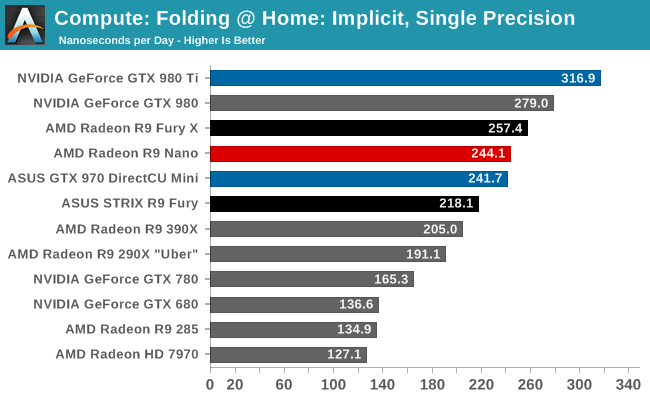
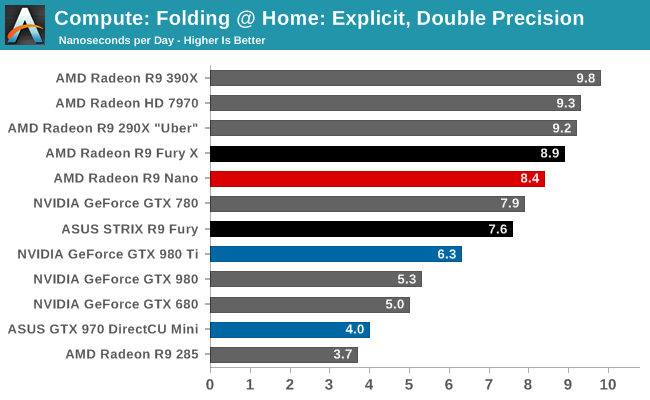
Much like CompuBench and LuxMark, the R9 Nano punches above its weight here. The lack of a graphics workload – and resulting demands on graphics hardware like the ROPs – means most of the card’s power can be allocated to the shaders, allowing higher clockspeeds. This gives the Nano a boost in this situation to bring it much closer to the Fury X, though as far as Folding goes AMD will still trail NVIDIA’s best cards.
Wrapping things up, our final compute benchmark is an in-house project developed by our very own Dr. Ian Cutress. SystemCompute is our first C++ AMP benchmark, utilizing Microsoft’s simple C++ extensions to allow the easy use of GPU computing in C++ programs. SystemCompute in turn is a collection of benchmarks for several different fundamental compute algorithms, with the final score represented in points. DirectCompute is the compute backend for C++ AMP on Windows, so this forms our other DirectCompute test.

Our final test sees the R9 Nano brought back to its place behind the R9 Fury, as the C++ AMP sub-tests are strenuous enough to cause more significant clockspeed throttling. Even behind the R9 Fury the R9 Nano does well for itself here, coming in behind the GTX 980 Ti and head of the R9 390X and GTX 980.










284 Comments
View All Comments
D. Lister - Sunday, September 13, 2015 - link
The Fermi architecture did indeed have those flaws, not to mention the thermal issues of the 4xx family and the strict power budget of the 5xx series that Nvidia stupidly enforced on its partners. The latter resulting in CTD in the factory overclocked models in some poor PC ports like Crysis 2, where the only solution was to downclock the GPU to its reference state. But despite such rare lapses, Nvidia has evolved steadily, and every generation has rectified the flaws of its predecessor, and improved in terms of features, power usage and temps.Oxford Guy - Tuesday, September 15, 2015 - link
Don't forget the driver that bricked Fermi cards.D. Lister - Sunday, September 13, 2015 - link
@medi03Sorry, but that nonsense just doesn't cut it anymore. Not after so many years of the same fraudulent babble going on over and over.
If someone "uneducated" was told that product A and product B both performed the same, yet product A could be bought for less money, than most people would go for product A.
If that is not happening than obviously there is more to this than purely performance/dollar(*), and the market is a lot more educated in the year 2015 than your fanboy delusions would've led you to believe.
Honestly, you AMD fanatics are like the Westboro Baptist Church of technology. I wouldn't be surprised if you lot started picketing outside the Intel and Nvidia HQs with "God hates Intel/Nvidia" placards.
*-Sadly, thanks to that HBM gimmick, AMD doesn't even have the performance/dollar feature anymore. The Nano's MSRP equals the 20-30% stronger 980Ti's retail value, and because of its rarity, actually is more expensive than the 980Ti.
medi03 - Monday, September 14, 2015 - link
I don't recall talking about "performance dollar", why do you have to lie like that? Is that your imagination?There were CLEAR, HANDS DOWN cases of inferiour products, be it nVidia's Fermi chips, or Intel's Prescott P4 fiasco outselling the competitor. That shows how much clue our "uneducated" public has. End of story.
Now take a deep breath and think if you really have some argument.
D. Lister - Monday, September 14, 2015 - link
"I don't recall talking about "performance dollar", why do you have to lie like that? Is that your imagination?"Tsk, tsk, "reading" is obviously not your strong suite.
"There were CLEAR, HANDS DOWN cases of inferiour products, be it nVidia's Fermi chips, or Intel's Prescott P4 fiasco outselling the competitor. That shows how much clue our "uneducated" public has. End of story."
That's your argument? Really? Where can anyone actually even buy Prescotts or Fermis these days? Who is buying them? In those times AMD's market share was significantly higher than it is now and quite rightfully so, rendering your abysmal argument completely moot. And the story didn't end there you silly little man - after Fermi there was Kepler, and then Maxwell. After Prescott there were over a dozen processor families, each and every single one an improvement, not just in raw performance but also in performance/watt and performance/dollar.
Granted that AMD has had improvements as well, but thanks to the terrible decisions of the businessmen at the top (e.g. selling their foundries and getting ATI for a lot more than it was worth, not focusing on their primary markets and losing loyal fans to other companies, etc.), not to mention the terrible software support for often very decent hardware and regularly over-promising and under-delivering, they are where they are now. The facts are ultimately in the ledgers, and mindless corporate drones like yourself can make up absurd stories and conspiracy theories as much as you like - fact is that AMD is dying and as their funds keep shrinking, so does the overall quality of their products, especially compared to the competition.
"Now take a deep breath and think if you really have some argument."
All I can do is shake my head and smile sadly at how completely you miss the irony in your statement. It's okay, once AMD is inevitably ripped apart and its pieces consumed by the corporate sharks and the AMD and Radeon brands are reduced to forgotten footnotes in tech history, cretins like you will find something else to fill the void in your pathetic, pointless existence. Have a nice life, if you can, I'm done with you.
D. Lister - Monday, September 14, 2015 - link
Just to make it very clear (again) to any AMD fans that may feel my sentiments to be overtly harsh towards their favored company, I personally believe that whatever has happened to AMD in the last decade or so, is nothing short of a heart-breaking tragedy, where the business fat cats at the top repeatedly made poor short-term decisions and exploited the hard work of brilliant engineers and technicians, giving themselves and their marketing lackeys bigger paychecks while the R&D starved, resulting in AMD as a company never truly reaching its full potential. And we all, as consumers and enthusiasts are worse off for it.Oxford Guy - Tuesday, September 15, 2015 - link
Too bad for that summary that it ignores the well-made products that AMD's customers have enjoyed and the industry has benefited from.D. Lister - Tuesday, September 15, 2015 - link
@Oxford GuyThat is a given, no? A company that is a complete failure from the start, with everybody under the sun hating their products, can't ever hope to eventually go public, let alone go toe-to-toe, even if for a little while, with an industry giant like Intel.
Unfortunately what AMD did right was rather consistently far outweighed by what they did wrong. For every satisfied customer, they had several that felt screwed over.
AMD is like a race car that has had very good parts, but a lazy pit crew and blind men at the wheel (I resisted the urge of saying "bad drivers", but I'm being too serious here to indulge with lazy puns). So you're reminding me that they pulled a few laps in good time, while I'm lamenting the race that they have nearly lost.
Oxford Guy - Saturday, September 19, 2015 - link
Nice fiction.D. Lister - Sunday, September 20, 2015 - link
lol, thanks. All facts can be reduced to mere fiction when faced with absolute, fanatical denial. But to be fair, yours is hardly the worse, there are still many people who doggedly believe that geocentricism is the truth and all else is lies and fiction.